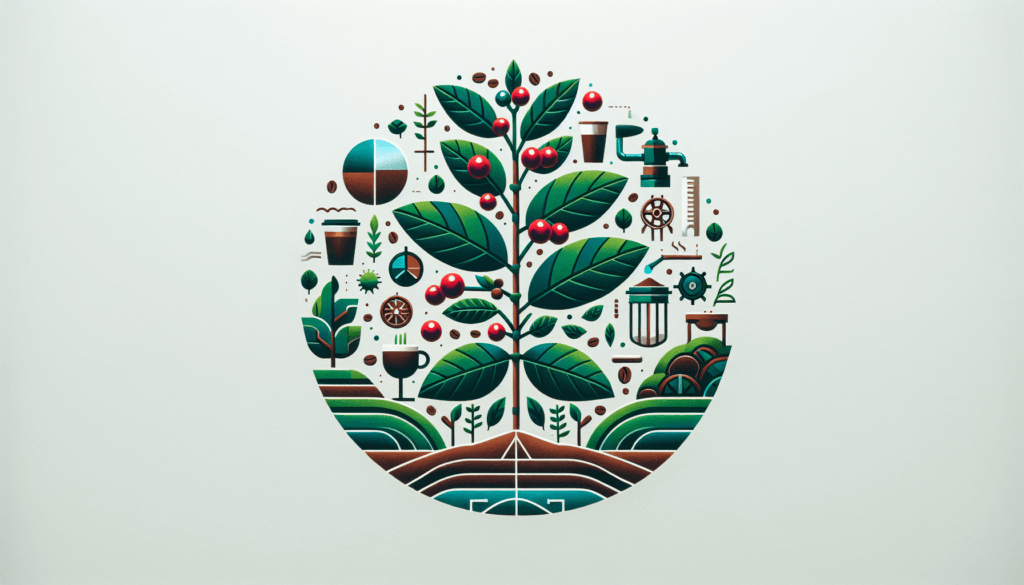Hey there coffee lover! Ever wonder where that delicious cup of joe you’re sipping on every morning comes from? Well, get ready to be surprised! In this article, we’ll take a journey to uncover the origins of the coffee that fuels America. From the tropical regions of Central and South America to the highlands of Africa and the Indonesian archipelago, we’ll discover the countries that supply the most coffee to the United States. So, grab your favorite mug and let’s explore the world of coffee together!

1. The History of Coffee in the US
1.1 Early Coffee Cultivation in the US
Coffee first arrived in the United States in the mid-17th century, brought by British colonists. The initial attempts to cultivate coffee were made in the southeastern states, particularly in Virginia. However, the climate and soil conditions were not ideal for coffee cultivation, which led to limited success. Despite these challenges, coffee became increasingly popular among the American colonists.
1.2 Rise of Coffee Consumption in the US
In the late 18th century, coffee consumption surged as Americans began to embrace it as their preferred hot beverage. Coffee houses sprouted across major cities, becoming centers of intellectual and political discussions. The American Revolution further fueled the demand for coffee, as tea imports from Britain declined. With the invention of the coffee percolator in the early 19th century, brewing coffee became more accessible, leading to widespread consumption.
1.3 Expansion of Coffee Farms in the US
As coffee consumption continued to rise, the need for domestic coffee production became evident. In the early 19th century, coffee plantations were established in states such as Georgia, South Carolina, and Louisiana. However, the success of these plantations was short-lived due to frost and disease. The shift towards coffee cultivation in Hawaii and California would later provide new opportunities for coffee production in the US.
2. Coffee Production in Hawaii
2.1 Ideal Coffee Growing Conditions in Hawaii
Hawaii’s unique geographical position and volcanic soil create optimal conditions for coffee cultivation. The state’s diverse microclimates, ranging from the cooler slopes of Mauna Loa to the warmer coastal areas, allow for the cultivation of different coffee varieties. The combination of abundant sunshine, regular rainfall, and fertile soil makes Hawaii an ideal location for producing high-quality coffee beans.
2.2 Kona Coffee – A Famous Hawaiian Specialty
Kona coffee, grown on the slopes of the Hualalai and Mauna Loa mountains on the Big Island of Hawaii, is renowned for its exceptional quality and flavor. The rich volcanic soil, combined with the ideal climatic conditions of Kona, results in a smooth and well-balanced cup of coffee. The small-scale, family-owned farms in the region handpick the coffee cherries, ensuring only the finest beans are used for production.
2.3 Other Coffee Varieties in Hawaii
While Kona coffee receives the most recognition, there are other coffee varieties cultivated in Hawaii. The Maui, Molokai, and Kauai regions also produce exceptional coffee beans. Maui coffee, grown on the slopes of Haleakala, offers a sweet and vibrant flavor profile. Molokai coffee, known for its smooth and mellow taste, thrives in the island’s high altitude. Kauai coffee, grown on the “Garden Isle,” boasts a rich and full-bodied flavor.

3. Coffee Cultivation in California
3.1 Unique Coffee Growing Regions in California
California’s diverse climate and topography have given rise to several distinct coffee-growing regions. In the southern part of the state, the Santa Barbara and Ventura counties provide ideal conditions for growing coffee. The coastal fog, coupled with the warm days and cool nights, creates a microclimate conducive to coffee cultivation. In the north, the Sacramento Valley and the Sierra Nevada foothills offer different growing conditions, resulting in unique flavor profiles.
3.2 The Specialty Coffee Scene in California
California has become a hub for specialty coffee, with numerous boutique roasters and cafes spread throughout the state. The focus on quality and sustainability is evident in the thriving specialty coffee scene. Roasters prioritize sourcing ethically and establishing direct relationships with farmers. The use of innovative brewing methods and the emphasis on showcasing single-origin coffees have made California a destination for coffee enthusiasts.
4. The Influence of Central and South America
4.1 Coffee from Central American Countries
Central American countries such as Guatemala, Costa Rica, and Honduras have played a significant role in the US coffee market. Guatemala, known for its distinct coffee profiles, produces beans with a wide range of flavors, from citrusy and floral to chocolaty and nutty. Costa Rican coffee, characterized by a clean and balanced taste, is renowned for its high quality. Honduras, on the other hand, has emerged as a major supplier of coffee due to its favorable growing conditions and focus on sustainable practices.
4.2 Coffee from South American Countries
South American countries like Colombia, Brazil, and Peru are major contributors to the US coffee market. Colombian coffee, often associated with a bright acidity and medium body, has a long history of excellence. Brazil, as the world’s largest coffee producer, offers a wide variety of beans, ranging from the commercial-grade to specialty-grade. Peruvian coffee, which is gaining recognition for its complexity and unique flavors, is produced in the high-altitude regions of the Andes.
4.3 Fair Trade and Sustainable Practices in Central and South America
Many coffee-producing countries in Central and South America have embraced fair trade and sustainable practices. This ensures that growers receive fair compensation for their hard work and promotes environmentally friendly farming methods. Organic certifications and initiatives for improving living conditions for farmers have gained traction in the region. By supporting these practices, consumers in the US contribute to the sustainability and social responsibility of the coffee industry.

5. The Gulf Coast and Southern States
5.1 Coffee in Louisiana and the Chicory Tradition
Louisiana’s coffee culture is unique due to its traditional addition of chicory. Introduced during the Civil War when coffee supplies were scarce, chicory became a popular substitute and eventually became a beloved flavor in its own right. Coffee and chicory blends, often enjoyed with beignets, are a staple in New Orleans. The distinct flavor and cultural significance of this tradition have made Louisiana a prominent player in the US coffee scene.
5.2 Coffee in Florida and Puerto Rico
Florida, although not a major coffee producer, has a vibrant coffee culture influenced by its diverse population. Cuban and Latin American coffee traditions have shaped the local coffee scene, with strong and sweet Cuban-style espresso being a favorite. Puerto Rico, a US territory, has a rich coffee history. With its unique microclimates, the island produces specialty coffee known for its bright acidity and pronounced flavors.
5.3 Coffee in Texas and the Rise of Specialty Roasters
Texas has witnessed the rise of specialty coffee roasters, particularly in cities like Austin and Dallas. These roasters prioritize sourcing high-quality beans from around the world and meticulously crafting the perfect roast. Texans have embraced the specialty coffee movement and appreciate the complex flavors and nuances that specialty coffee offers. The expanding coffee scene in Texas showcases the state’s commitment to quality and innovation.
6. East Coast Production and the New England Connection
6.1 Coffee in New York and New England
New York City, with its vibrant coffee culture, has a thriving specialty coffee scene. Local roasters focus on direct trade relationships with coffee farmers, ensuring the highest-quality beans. The influence of New England’s history as a major trading hub is also evident in the coffee culture. Boston, in particular, has a traditional connection to coffee dating back to the colonial era, making it an essential part of the East Coast coffee landscape.
6.2 Coffee Farms in Pennsylvania and Virginia
Pennsylvania and Virginia have seen the emergence of small-scale coffee farms in recent years. These farms, though small in size, have made a significant impact on the local coffee industry. The focus is on sustainability and producing high-quality, ethically sourced beans. The coffee farms in these states provide an opportunity for coffee enthusiasts to connect directly with growers and experience locally grown and roasted coffee.
6.3 Unique Coffee Roasters in the Mid-Atlantic Region
The Mid-Atlantic region has witnessed the growth of unique coffee roasters that blend tradition with innovation. With a rich history and diverse population, cities like Philadelphia and Baltimore have become hubs for coffee roasting. These roasters experiment with different flavors and brewing techniques, constantly pushing the boundaries of what coffee can offer. The Mid-Atlantic region’s coffee scene is a testament to the creativity and passion of its coffee artisans.

7. The Midwest and Emerging Coffee Markets
7.1 Growing Coffee Scene in Chicago
Chicago’s coffee scene has seen significant growth in recent years, with an emphasis on specialty coffee and unique cafe experiences. Local roasters in the city prioritize sustainability and ethical sourcing, showcasing the diversity and complexity of coffee. Chicagoans have embraced the flourishing coffee culture, making it a destination for coffee lovers seeking exceptional brews.
7.2 Specialty Coffee in the Midwest
The Midwest is home to several emerging specialty coffee markets. Cities like Minneapolis, St. Louis, and Kansas City have witnessed the rise of specialty coffee shops and roasters, attracting a new wave of coffee enthusiasts. The emphasis on quality and craftsmanship has led to the establishment of unique brewing methods and the exploration of different flavor profiles. The Midwest’s coffee scene continues to evolve, contributing to the regional coffee culture in the US.
7.3 Other Emerging Coffee Markets in the Midwest
Beyond the major cities in the Midwest, there are other emerging coffee markets worth noting. Indianapolis, for instance, has seen a growth in specialty coffee shops, driven by a vibrant local food and beverage scene. Milwaukee, with its thriving arts and culture scene, has also experienced the emergence of specialty coffee shops and roasters. These smaller markets are contributing to the overall growth and diversification of the Midwest’s coffee industry.
8. The Pacific Northwest’s Coffee Obsession
8.1 Seattle – The Birthplace of Starbucks
Seattle, Washington, holds a special place in the history of coffee in the US. It is the birthplace of Starbucks, one of the world’s largest coffee chains. Starbucks’ success propelled Seattle into the spotlight as a coffee mecca. The city has a strong coffee culture, with a plethora of local coffee shops and roasters offering a wide range of experiences for coffee lovers.
8.2 Coffee Culture in Portland, Oregon
Portland, known for its embrace of all things artisanal, has a vibrant coffee culture. The city boasts a multitude of independent coffee shops and micro-roasters. Portlanders take pride in their coffee, and the emphasis on sustainability and direct trade relationships is evident in the local coffee scene. The city’s commitment to quality and innovation has helped shape the Pacific Northwest’s reputation as a coffee destination.
8.3 Specialty Coffee Roasters in Washington and Oregon
Washington and Oregon are home to numerous specialty coffee roasters, each with their unique offerings. Roasters in these states prioritize small-batch production, ensuring meticulous attention to detail in the roasting process. From Seattle’s iconic roasters to the artisanal micro-roasters in Portland, Washington and Oregon have solidified their positions as key players in the specialty coffee industry.

9. The Influence of African and Asian Countries
9.1 Ethiopian Coffee and Its Impact on the US Market
Ethiopian coffee holds a special place in the hearts of coffee aficionados around the world. Known for its distinct flavor profiles, Ethiopian coffee is often characterized by its floral and fruity notes. In the US market, Ethiopian coffee has gained popularity, with specialty coffee shops showcasing different Ethiopian regions and their unique coffees. The vibrant flavors of Ethiopian coffee have had a significant influence on the US coffee scene.
9.2 Coffee from Other African Countries
Apart from Ethiopia, other African countries contribute to the diversity of coffee available in the US. Countries like Kenya, Tanzania, and Rwanda produce exceptional specialty coffees with their own distinct characteristics. Kenyan coffee, known for its bright acidity and complex flavors, is highly sought after by coffee connoisseurs. Tanzanian coffee offers a wide range of flavor profiles, while Rwandan coffee is celebrated for its delicate sweetness.
9.3 Coffee from Asian Countries
Asian countries, such as Indonesia and Vietnam, also play a role in the US coffee market. Indonesian coffee, particularly from regions like Sumatra and Java, is renowned for its full-bodied and earthy flavors. Vietnamese coffee, often enjoyed in the form of the strong and sweet Vietnamese iced coffee, has gained popularity among coffee enthusiasts. The unique flavor profiles of coffee from Asia add depth and diversity to the US coffee scene.
10. Importing and Blending of Coffee in the US
10.1 Role of Coffee Importers and Distributors
Coffee importers and distributors play a crucial role in bringing coffee from around the world to the US market. They establish relationships with coffee growers, ensuring transparency and fair trade practices. Importers and distributors also handle the logistics of transportation and ensure that coffee arrives in the US in optimal conditions. Their expertise and connections facilitate the flow of specialty coffees into the US.
10.2 The Art of Coffee Blending
Coffee blending is the practice of combining different coffee beans to create unique and balanced flavor profiles. Blending allows roasters to highlight specific characteristics of different beans and create complex, well-rounded blends. In the US, coffee blending has become an art form, with roasters experimenting with various combinations to cater to different consumer preferences. Blending opens up a world of possibilities for creating distinct flavor experiences.
10.3 Consumer Preferences and the Rise of Single-Origin Coffees
In recent years, there has been a growing demand for single-origin coffees in the US. Single-origin refers to coffee beans sourced from a specific geographic area, allowing consumers to experience the unique flavors of that region. Whether it’s the fruity notes of Ethiopian coffee or the chocolatey undertones of Colombian coffee, single-origin coffees provide an opportunity to explore the diversity of flavors found in different countries. This consumer preference has driven the availability and popularity of single-origin coffees in the US market.
In conclusion, the history of coffee in the US is a rich tapestry of cultural influence, geographical diversity, and innovative practices. From the early cultivation attempts to the rise of specialty coffee, each region has contributed to the growth and evolution of the US coffee scene. Whether it’s the famous Kona coffee of Hawaii, the thriving specialty coffee markets in California and the Pacific Northwest, or the cultural traditions found in the Gulf Coast and Southern states, the US offers a diverse and vibrant coffee culture for enthusiasts to explore. With influences from Central and South America, Africa, and Asia, combined with the art of coffee blending and the rise of single-origin coffees, the US market continues to evolve to meet the ever-changing preferences of coffee lovers.


